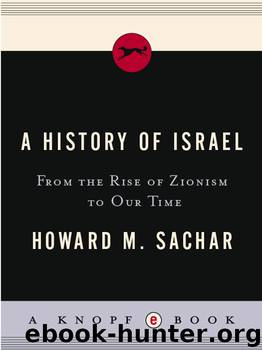A History of Israel: From the Rise of Zionism to Our Time by Howard M. Sachar

Author:Howard M. Sachar [Sachar, Howard M.]
Language: eng
Format: epub
Tags: Jewish, Israel & Palestine, Middle East, History
ISBN: 9780804150491
Google: 0X4BAAAAQBAJ
Publisher: Knopf Doubleday Publishing Group
Published: 1977-01-02T00:00:00+00:00
THE STRUGGLE FOR FLEXIBILITY WITHIN ORTHODOXY
In the wake of the government’s surrender following the Shalit case, public revulsion against the Orthodox establishment became almost uncontainable. There was widespread identification with an open letter written to Prime Minister Golda Meir by Chanan Frank, who had immigrated to Israel from the Netherlands in 1968 with a Dutch mother and a Jewish father. Serving in the army, he had lost both legs to an Egyptian mine. In his letter, Frank asked if he was not now to be considered a Jew by nationality according to the new amendment. He himself was religious, but presumably would not be accepted as a “national” Jew unless his mother were converted by Orthodox procedure in Israel, a step she refused to take. For years it had been Orthodox practice in Israel to make conversion of non-Jewish women extremely difficult. Indeed, applicants were denied more often than accepted. Not infrequently local rabbis turned down women simply because they belonged to kibbutzim that were not affiliated with the National Religious party. The secularists asked how much longer this kind of medievalism was to paralyze an otherwise free society.
By the early 1970s there were faint indications that the rabbinate was becoming at least somewhat less obstructive, if only in response to mounting public outrage and the threat of Knesset action against Orthodox dominance in the sphere of marriage and divorce. In March 1971, the rabbinical council, presided over by Chief Ashkenazic Rabbi I. Y. Untermann, decided to offer a minor concession on the conversion issue. It was to waive the one-year “test of intention” waiting period for immigrants arriving from east European countries. The process of conversion would be carried out in a “shorter time.” Both unrest and auguries of change reached a denouement of sorts in yet another legal case—this one, however, before the rabbinical rather than the secular courts. At issue was the desire of a brother and sister, Chanoch and Miriam Langer, to marry the partners of their choice. Their mother had been married some decades earlier, to a Gentile Pole, Abraham Borkovsky, who had been converted to Judaism before the marriage. After the establishment of Israel, Borkovsky’s wife fell in love with a Jew, Langer, and departed with him for Israel, where she had two children by him, Chanoch and Miriam. Only afterward did she seek and receive a divorce from Borkovsky at the hands of an Israeli rabbinical council. The children reached adulthood, then applied to the Petach Tikvah rabbinical court to marry. They were turned down because they were mamzerim.
The term “mamzer” was by no means synonymous with “bastard.” A bastard was one born out of wedlock, and under religious law suffered only minor legal and moral obloquy. A mamzer, on the other hand, as defined by the Halachah, was a child born of an adulterous or incestuous relationship—and exclusively between a married woman and someone other than her husband. The only restrictions, too, imposed even against a mamzer in Orthodox law were marital ones; in all other respects there were no penalties.
Download
This site does not store any files on its server. We only index and link to content provided by other sites. Please contact the content providers to delete copyright contents if any and email us, we'll remove relevant links or contents immediately.
| Africa | Americas |
| Arctic & Antarctica | Asia |
| Australia & Oceania | Europe |
| Middle East | Russia |
| United States | World |
| Ancient Civilizations | Military |
| Historical Study & Educational Resources |
Empire of the Sikhs by Patwant Singh(22921)
The Wind in My Hair by Masih Alinejad(5018)
Rise and Kill First by Ronen Bergman(4669)
The Templars by Dan Jones(4610)
The Rape of Nanking by Iris Chang(4115)
12 Strong by Doug Stanton(3466)
Blood and Sand by Alex Von Tunzelmann(3112)
The History of Jihad: From Muhammad to ISIS by Spencer Robert(2551)
Babylon's Ark by Lawrence Anthony(2505)
No Room for Small Dreams by Shimon Peres(2299)
Inside the Middle East by Avi Melamed(2288)
The Turkish Psychedelic Explosion by Daniel Spicer(2287)
Gideon's Spies: The Secret History of the Mossad by Gordon Thomas(2286)
Arabs by Eugene Rogan(2244)
The First Muslim The Story of Muhammad by Lesley Hazleton(2199)
Come, Tell Me How You Live by Mallowan Agatha Christie(2097)
Bus on Jaffa Road by Mike Kelly(2088)
Kabul 1841-42: Battle Story by Edmund Yorke(1967)
1453 by Roger Crowley(1929)
